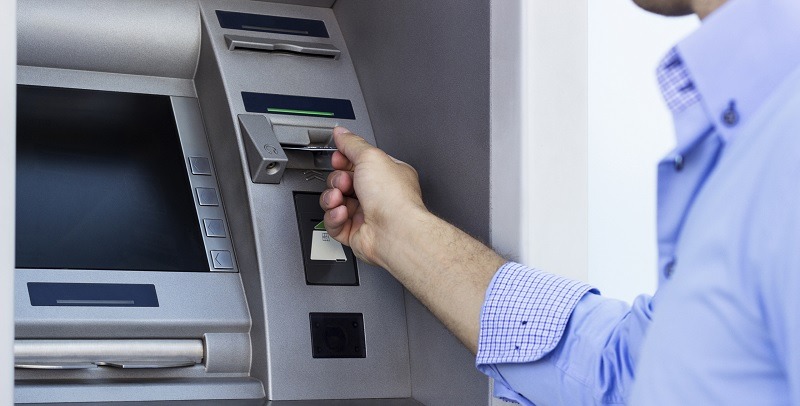
An ATM card is a PIN-based card that you can use at ATMs or at places using one of the same electronic ATM networks that’s listed on the back of your card. You usually get a free card to access your money when you open a checking account with the bank.
The cards can be used for cash withdrawals, balance inquiries, and deposits at most ATMs. To tell if you card can make purchases, look for a logo on the card! If there is no logo, you have an ATM card that’s only good for use at an ATM.
Spend a few minutes of your day to learn if you can make purchases with an ATM Card!
Find the best bank bonuses from banks like Chase, Huntington, HSBC, BBVA, Bank of America, Citibank, TD, Ally, Discover, and more!
Look At ATM Card Issuer and Retailer Policies
All the ATM card issuers and retailers out there have different policies. Regardless if you use a credit card or a debit card as your ATM card, you should be able to use it for online purchases. Prepaid cards are a little bit more confusing because it depends on the exact type of card you have and if the card is registered to your name and address.
Simply follow the instructions provided on the retailer’s website step by step. Also, try to make these purchases when you aren’t in a hurry to minimize any potential mistakes. Here are some key points to remember:
Protect your ATM card or debit card while shopping online
Any time you enter your card number online, there’s a risk that a hacker might steal your information and use it for malicious purposes. With that being said, your best bet is to use a credit card rather than an ATM card.
The way this works is your credit card essentially makes a “loan” from your bank, while purchasing with an ATM card immediately draws funds from your checking account.
Follow four steps to minimize online shopping risks:
- Purchase through a reputable seller
One of the easiest things to increase your security is to purchase from a reliable seller and website or merchant. Although there is greater security, your card data can still be stolen. - Keep your checking records up to date
If your only option is to use an ATM, make sure you do a bank reconciliation at the time of your purchase to make sure you aren’t charged overdraft fees. - Be aware of fraud
When using ATM cards, be sure to monitor more frequently, even more frequently than using more credit cards. Review your bank account transactions to make sure there aren’t any fraudulent charges or inappropriate charges on your debit card. To avoid this, check your account on a regular basis or sign up for fraud alerts. - Report fraud quickly
The use of ATM cards or debit cards often require you notify the issuer of any unauthorized use within two days in order to limit your liability. Additionally, there is much less protection from fraudulent purchases when using debit cards than credit cards.
Although there is fraud protection when using credit cards, avoid racking up more debt than you can pay off.
Avoid making purchases on public Wi-Fi
Your safest bet when making online purchases would be to only make purchases from your home wireless connection. The reason that public Wi-Fi is such as risk is that most public Wi-Fi sources tend to vary in security and there are devices that can intercept wireless signals that can then steal sensitive financial information.
Modern banking comes with many conveniences such as ATM cards, but customers should still be careful to not turn that convenience into a financial mistake.
How to Use Your Card
The first thing you must do is check if your card has a payment network logo. It’s technically considered a debit card, and you can use it as if it was a credit card if it does have the logo. At a retailer, swipe the card or insert the chip and the money will come out of your checking account no matter if you choose debit or credit.
Most cards issued with checking accounts are fully-functioning debit cards. However, it’s not uncommon to have an ATM card that does not work as a debit card. In particular, if your bank account is a savings account, then your card is most likely only good for ATM use.
Types of Cards
- ATM cards are the simplest type of card, generally only be used at an ATM for basic banking transactions such as withdrawing cash, making deposits at deposit-enabled ATMs, finding out how much money is in your account, and transferring funds between accounts.
- Debit cards allow you to spend from your checking account anywhere cards are accepted. They also do everything that ATM cards can do. The funds will come directly from your checking account. Debit cards do protect against fraud and errors, but you have to report the issue quickly.
- Credit cards allow you to borrow from your credit card issuer. Funds do not come directly out of your checking account because you build up a loan balance that you pay off at a later date. You should aim to pay off the entire balance every month so that you don’t pay interest or late fee charges. Credit cards are safer than debit cards for everyday spending because they don’t pull directly from your checking account and they offer better consumer protection against fraud.
- Prepaid debit cards are similar to standard debit cards, but they don’t pull from a checking account. Instead, you load funds into your account with the card issuer by adding funds and spending the money you loaded into the card. You can also withdraw cash at an ATM and pay bills online with prepaid cards. You don’t rack up debt with prepaid cards and they’re often easy to qualify for.
 |
 |
Bottom Line
Do you have an ATM card? You will usually get one when you open a checking account. These cards can access most ATM’s for cash withdrawals, balance inquiries, and deposits.
It is important to understand what you can do with an ATM card, debit card, credit card, and prepaid card. Take some time to learn the basics! Check out our Bank Bonuses, Saving Rates and Credit Card Bonuses!



